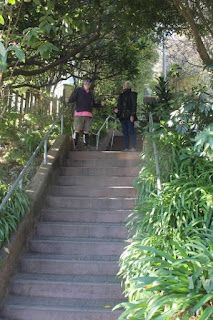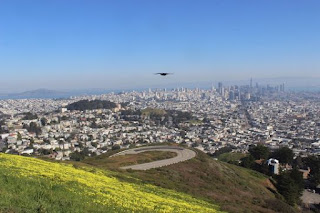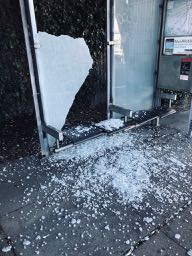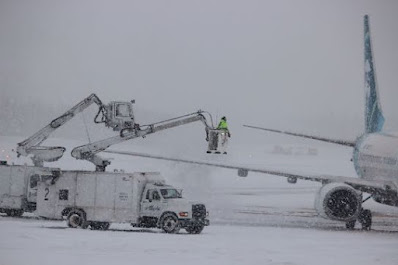The Board met and passed the policies recommended by the staff. The main change they made was to combine the meals ($60) and incidentals ($25) into on $85 which, it seems bumps up their meal allowance when traveling. There was no mention or discussion of whether it was appropriate for that to cover alcohol. Board member Melanie Bahnke, the President and CEO of Kawerak, a Native non-profit Corporation of the Bering Straits Native Association, asked that her pay go to Kawerak because that's the corporation's policy when employees do this sort of work on corporation time. Staff thought that could be arranged but will check.
One item was added to the published agenda - an update on the progress of the website. The staff is working on it, but no dates were given for when it goes up.
Chair Binkely reiterated several times that these policies could be revisited and amended if that seemed necessary.
I posted the other day saying I didn't think a board like this should be asked to set its own compensation. I further raised various ethical and socio-economic questions about the role of public boards like this. My personal sense is that in many cases per diem and travel allowances are often abused by both private and public sector employees. I agree fully that members of such boards shouldn't have to spend out-of-pocket to serve on boards, but I also feel that given Alaska's severe cutting of public programs because of the drop in oil revenues, that members of public boards, particularly when they have other well paid jobs besides their board appointments, should be very conscious that many people, many children in Alaska today eat on much less than $60 a day, let alone $85.
Again, this is something I feel is important and not really aimed at the Board itself, but more at the contradictions between some politicians who vigorously promote cutting the budget and then want to be generously compensated by a government agency.
Below is my rough transcript of the meeting as I listened in by phone. Occasionally I had trouble identifying who was speaking and I try to indicate that with a question mark. This is not verbatim, but it's enough to get the gist of the discussion. Audio tape will eventually be up at this link (and later on their own website when they get that up.
[I've included some of the staff recommendations from the Documents for the meeting which were online as well.]
Alaska Redistricting Board January 26, 2021
Present: Board members: Nicole Borromeo, Melanie Bahnke, Bethany Marcum, Budd Simpson, John Binkley,
Staff: Peter Torkelson and TJ TJ Presley
Open meeting at 2:34
Approval of Agenda - Simpson - amend to add # 6 Webpage
Adopted
Agenda
1. Call to order
2. Establish a quorum
3. Adoption of agenda
4. Board Policy Review and Discussion
a. Public Meeting and Notice Policy
b. Public Records Policy
c. Member Compensation Policy
d. Member & Staff Travel Per Diem Policy
5. Adoption of One or More Board Policies
Added new 6 -Website progress - and made Adjournment 7
6. Adjournment
- Board Policy Review and Discussion
Turn it to Peter
Peter: Worked through this. TJ drafted the first two. (Hard to understand)
Public Meetings and Notices Policy:
Melanie - about screens on Zoom
Dept Director TJ Presley:
Public Meeting - how the board communicates to public about when there’s a meeting. Executive and Legislative branch policies. Executive Branch uses public meetings - all bodies, pretty broad.
Notice given reasonable time, but no definition. (Reviewing info in documents covered in earlier post on the Board.)
Banke: It’s hard to understand, very muffled.
Move to Second Policy Public Records Policy
Hoping to procure a minutes taker as well. How to keep records varies. AIDEA - has statutory requirements. Legislature has uniform rules - court proceedings electronically.
In this case Board could adopt Legislative or Administrative.
Staff recommendation - electronic recordings and minutes provided. (Again see previous post )
More discussion about TJs audio.
Peter doing quick summary. Here’s the official written staff rec:
Meetings and Notice
“Staff Recommendation: Redistricting Board should adopt Alaska Open Meetings law, AS 44.62.310, as its public notice requirements. This action directs staff to ensure notice of themeeting, its location, attachments, and teleconference options, would be posted to the Alaska Public Notice System website within a “reasonable time”. Staff will further make notice of its meetings available on the legislative website.
It is the policy of the Alaska Redistricting Board that the board comply with the Alaska Open Meetings act and seek to provide 72 hours of public notice prior to board meetings with 24 hours notice being allowable. Notices shall be posted to the State of Alaska Public Notice System.
Advance public notice can be difficult if you aren't organized or if things come up at the last minute, but it's important for the public to be able figure out when the board is meeting. Furthermore, while the State Public Notice System is there, it's not something that most people regularly use.”
Public Meetings
"Staff Recommendation: Adopt a policy that includes recording and maintaining electronic copies of the audio recording of each meeting and keeping minutes that capture votes, motions, and a “brief statement of the position of any Board Members who makes a statement on the issue before the board” (This is modeled on legislative committee minute recording language). This could be a simple summary like, “Member A expressed concern that the proposed House District 12 did not take into account the city boundary”
It is the policy of the Alaska Redistricting Board that meetings be electronically recorded and made available to the public and that written minutes be kept of each meeting which identify motion makers, seconds, vote tallies and a brief summary of the concerns of any Board member who states a position on the issue under consideration.
Binkley: Public Notice questions?
Borromeo: Public Notice. On Legislature’s website? Tied to Governor’s office? I had problems finding us.
Peter: We were under umbrella of Legislature because they funded us. Now on both Alaska Notice dot Gov [I'd give you a url if I could figure out the right one- Steve] also on http://w3.akleg.gov/index.php#tab4 (?) So we’d be on both.
We have our own website being set up and we’ll notice there as well and also have email notification for those who subscribe.
Binkley: Compensation Policy. The Constitution says they should be compensated. Board members spend a lot of time on Board matters not just on meetings. We send hundreds of pages to the members. Done on daily rate, but should also cover hours working on Board issues not at meeting.
We recommend $477. Legislators at $486. We don’t know how many weeks we’ll have before Census Data arrives. This is our 8th meeting. Board has been in place about 5 ? months.
Banke - My company policy says it should be directed back to the organization since I’m doing this on company time. Otherwise I have to take personal leave each time.
John?: Check with Leg Legal.
Peter: Staff will check on how this gets done. I think it’s possible, but we need to check
Borromeo? - Presume every day a Board meeting being held? Not per day, right?
Peter: Per Board Meeting Day.
Budd: If 15 minute meeting, say procedural, I wouldn’t feel right about taking a full day meeting rate. Perhaps a half rate for shorter meetings.
Binkley? - in my experience - corporate boards, sometimes preparation is lengthy even if meeting short. It’s hard to quantify every possibility. It should balance out with time you spend preparing, meeting with public, but no recognition on that. Maybe we can proceed and make adjustments. I don’t see these policies as static.
Banke: Hand up? No, forgot to put it down.
Borromeo: I have same reaction that Budd did. I don’t think any of us accepted appointment to this Board to make money. In another board it’s a sliding scale. This is a high meeting fee, but it is in line with other Boards and commissions and if we can review it in the future, I’m comfortable moving forward.
Binkley: Travel and Per Diem Policy
Peter: Given COVID right now different. 2010 Board did numerous meetings around the state. We should be able to travel in the future. We’ve looked at different options. Using the AK Boards and Commissions policy.
Actual housing costs. $60 food and incidentals. We felt $25 for incidentals and $60 for transportation.
[From the documents:
"Staff Recommendation: Adopt a policy based on the State of Alaska Boards and Commissions Per Diem table with actual lodging and $60 per day for meals. Amend this to include up to $25 for incidentals and $60 per day for ground transportation or car rental to reflect the fact that board members may be sent on road shows to distant communities with little logistical support available on the ground. Provide the Board Chair the ability to waive policy caps if there is documented need (for example, renting a car in Utqiagvik may cost more than the specified daily car rental rate).
“'It is the policy of the Alaska Redistricting Board that members and staff receive per-diem reimbursement for actual lodging, meals to a value of $60, actual incidentals to a value of $25 and ground transportation to a value of $60 per day for board related travel that is authorized by the Board Chair or Executive Director. Reimbursement for actual costs incurred over the maximum amounts may be made at the discretion of the Board Chair.’”]
Banke: Up to $25 for incidentals. Is that by request or added to meals?
Peter: You can submit receipts for optional - topped at $60 and topped at $25.
Barromeo: All sounds good except for the meals at $60 per day. You’d be hard pressed to eat at that price in even Anchorage and Fairbanks. Can we raise it to $75? What do others think?
Budd Simpson: Agree it would be tight. Either way works for me.
??? : I agree with Nicole. What if we just mix meals and incidentals at $85 and all it good.
Peter: Board traveled with lots of maps that required skycaps to get them on planes.
Bethany? : I’m comfortable. I don’t thinks it’s reasonable to raise the rate, but if we merged with incidentals I’m ok, but otherwise don’t think we should raise it above $60.
Barromeo: I like the suggestion to merge the meals and incidentals to $85 and above that give receipts and get approval.
Binkley: Public Notice - Should include meetings AND Hearings and agree to change the per diem to meals and incidentals together at $85 and other actual expenditures require receipt and approval.
Banke? - Can we hold off til Peter gets confirmation they can take care of my issue of giving my payment to my corporation?
Binkley - I don’t think adopting this language would preclude that from happening.
Motion to adopt these? Seconded. Discussion? Hearing nothing. Motion adopted.
Web page discussion: Peter. We need to have a website so public can be introduced to what we’re doing etc. Also posting existing districts and maps. So public will have ready access to maps as they are adopted. Map section is core to website.
I can post some mock up examples for public to see.
Binkley: appreciate what you’re doing and that you want to get it out to the public so we can get public input. Any other comments?
Budd: Thanks to the staff for putting that together, Like the idea of using the old map as a graphic for this. Beside being interesting, it doesn’t emphasize urban or rural areas like modern maps do.
Barromeo? Thanks for making the changes I sent the other day.
Adjournment, but anything else first?
Barromeo? - consider prioritizing with various organizations to say what redistricting is - time to educate public before we get into the details.
Banke - traveling during quarantine hard from Nome because of quarantines, but things getting better, but next week I get my second shot. More available for people in rural areas than for Anchorage folks.
Adjourn? Borromeo, move. Budd Second.
Adjourned. 2:35








































